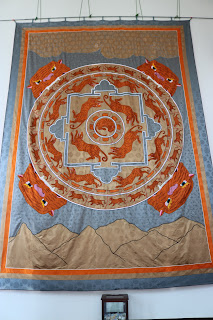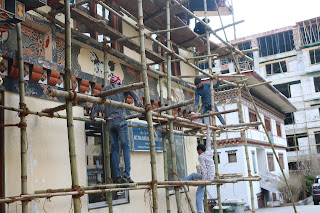March 16, 2018
Today was a very busy day. We toured several sites around the capital city of Thimphu. The Bhutanese government is striving to preserve a lot of their traditional craftsmanship while slowly moving toward a more modern environment.
First stop this morning was at the Royal Textile Museum and Academy. It is dedicated to educating and promoting the preservation of traditional textiles. It was opened in 2005 and students are taught weaving and embroidery.
Today was a very busy day. We toured several sites around the capital city of Thimphu. The Bhutanese government is striving to preserve a lot of their traditional craftsmanship while slowly moving toward a more modern environment.
First stop this morning was at the Royal Textile Museum and Academy. It is dedicated to educating and promoting the preservation of traditional textiles. It was opened in 2005 and students are taught weaving and embroidery.
Back strap looms
Next we visited the Handicrafts Emporium where local craftsman sell their wares. They had a wide variety of textile goods, carvings and paintings. We couldn’t take pictures inside but here is the outside. You can that they are working on some renovations. I love the bamboo scaffolding.
Takin is the National animal of Bhutan and we visited the preserve. The sign tells about these unique creatures.
A mother with her children dressed in traditional wear.
I love seeing the prayer flags. It is very similar to what you would see in Tibet.
Looking down into the valley at the town.
These mini stupas were placed along the side of the road. They contain the cremation remains of loved ones.
This is the Tashichho Dzong (fort). It houses a Buddhist monastery and the fortress serves as the seat of the head of Bhutan’s civil government. The king’s palace is located inside.
This represents the Bhutanese symbolism of Thuenpa Puen Zhi, the four harmonious friends. The story goes that the bird found the perfect place for the tree, the rabbit planted the seed, the monkey watered the seed and the elephant protected the tree. Thus, they all get to enjoy the shade.
Students at the Zorig Chusum - Arts and Crafts school that was established in 1971 to provide an opportunity for under privileged youth of the country to develop skills to help them create job opportunities. It is boarding school and the courses take from 1 - 6 years to complete.
Students can study carving, painting, sculpture, and embroidery.
This student was having the teacher check his work.
I like the five commitments of being a student.
Students working on large sculptures.
We also visited the National Library which has a goal of maintaining a collection of Bhutanese literature, ancient rare books, and manuscripts.
This is the largest book in the world as certified by Genius Book of Records.
This old document was dated from 1888.
These are old books written on flat pieces of paper and wrapped in cloth
Another example of the traditional architecture. The students from the school do the painting of the wood trim.
Next stop was the Jungshi paper factory. They use traditional methods to produce authentic Bhutanese paper known as Deh-sho. The bark of the Daphine tree is soaked in water, then boiled.
The fibers are then separated by hand before being pressed into sheets.
The sheets are hung on heated drying panels.
The Memorial Chorten is a stupa built in 1974. It is one of the main attractions in Thimphu as many people visit daily to offer their prayers.
Prayer wheels are turned by worshippers.
There are some very ornate doorways.
Last stop of the day was a new Buddha- Dordenma. Construction started in 2006 and the inside is still not completed. It is one of the largest Buddhas in the world at 169 feet tall. The construction is being financed by a Chinese corporation and is at over $100 million.
This is our travel group. From the left is Stephanie, Amandalei, E, Joy, and myself.
Tomorrow we leave Thimphu and travel over the 10,000 foot elevation point of Dochula Pass to Punakha.


















































No comments:
Post a Comment